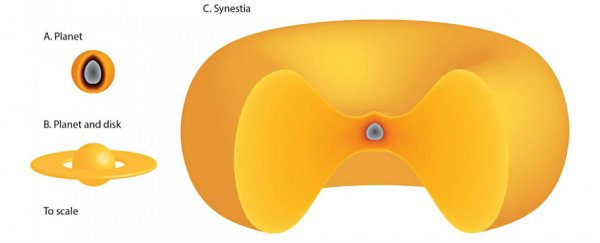Scientists have proposed that an unknown type of planetary object has been lurking in our Universe this whole time, and it might have even given rise to Earth as we know it.
Called a synestia, this doughnut-shaped object is thought to form when one planet slams into another, and if made official by the astronomy community, the term will be entered into textbooks as one of Earth's early forms.
"We show that rocky planets are vaporised multiple times during their formation, and are likely to form synestias," planetary scientists Simon Lock from Harvard University and Sarah Stewart at UC Davis report.
"The different structures of hot, rotating planets change our understanding of multiple aspects of planet formation, including the origin of our Moon."
The origin story of our planet is a tricky one, because the most widely accepted hypothesis is that a few billion years ago, a hypothetical Mars-sized object happened to form in the inner Solar System, right in the orbital path of a protoplanet that would eventually become Earth.
The two eventually collided - known as 'the giant impact' - and that cataclysmic blow sent masses of debris out into space, some of which formed our Moon.
What was left of the protoplanet and the mystery Mars-sized object (Theia) was Earth proper, which officially came to be at around 4.5 billion years ago. What became of Theia, on the other hand, has never been resolved.
Lock and Stewart have been investigating the exact moment when Earth was formed, and say this cataclysmic interaction is more complicated than we thought - there are actually more than one outcome when the Universe hosts such a violent event, and one of them gives rise to an object no one's ever actually witnessed before.
The first outcome is the one we're most familiar with - billions of years ago, a messy disc of debris encircled our Sun, which would gradually clump together to form bigger and bigger orbiting objects.
Eventually, these objects would get so big, when they collided, they'd form rocky planets like Earth, Mars and Venus.
Current thinking on planetary formation states that one of these objects is the protoplanet, and the other is the colliding catalyst that completes its transition into a proper planet.
If the colliding object is small, the newly formed planet would be showered with its shattered remains like meteorites. But if the colliding object is big enough, these shattered remains can orbit the newly formed planet for some time, like Saturn's rings, before eventually being swallowed up by it.
But what if the two colliding objects were equal in size? Without a clear protoplanet and colliding partner, who does what?
When Lock and Stewart modelled what happened when one very big and hot spinning object slams into a similar spinning mass at a very high angular momentum, they found that the most violent and evenly matched collisions would produce synestias - peculiar haloes of vaporised rock spinning around a molten core.
(In case you're wondering, "synestia" is an amalgam of syn, which means "together" in Greek, and Hestia - the Ancient Greek goddess of home and architecture.)
This new object, which only lasts for around a couple of hundred years, has a much larger volume than the two objects that collided, and would host no solids or liquids on the surface. It would also be much larger than a planet with surrounding disk.
"We looked at the statistics of giant impacts, and we found that they can form a completely new structure," says Stewart.
The team proposes that after a century or so in this form - a blink of an eye in the lifespan of a planet - a synestia will have lost so much heat, it would condense back into a solid. They suspect that most planets that exist today were synestias at some point.
If confirmed, the hypothesis not only gives us a whole new form for early Earth - it could also clear up some of the mystery surrounding the formation of our Moon.
Previous explanations for the Moon's formation involve Theia slamming into proto-Earth and breaking apart, with some of the debris being swallowed up by our planet, and some forming the Moon.
But chemical analysis on samples brought back by the Apollo missions in the 1970s indicated that Earth and lunar rocks are nearly identical.
Could the collision have formed a single synestia first, from which both Earth and the Moon later condensed? For now, the hypothesis is just that - we need more evidence to back up the claim.
But if this new planetary object is accepted by the astronomy community, we might finally be able to fill in some of the major gaps in the origin story of our planet.
The research has been published in the Journal of Geophysical Research: Planets.
